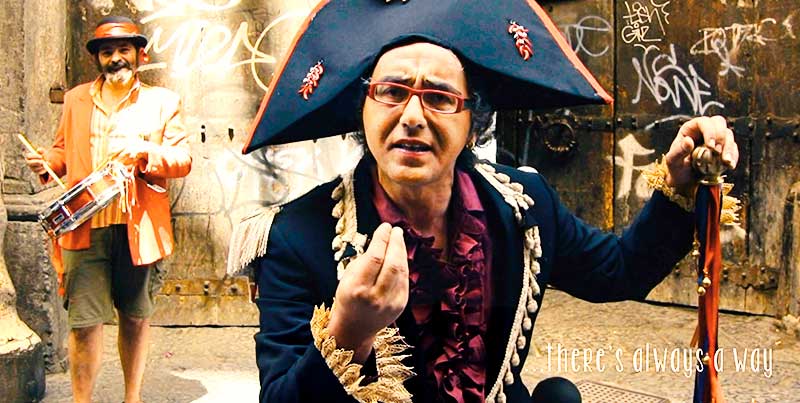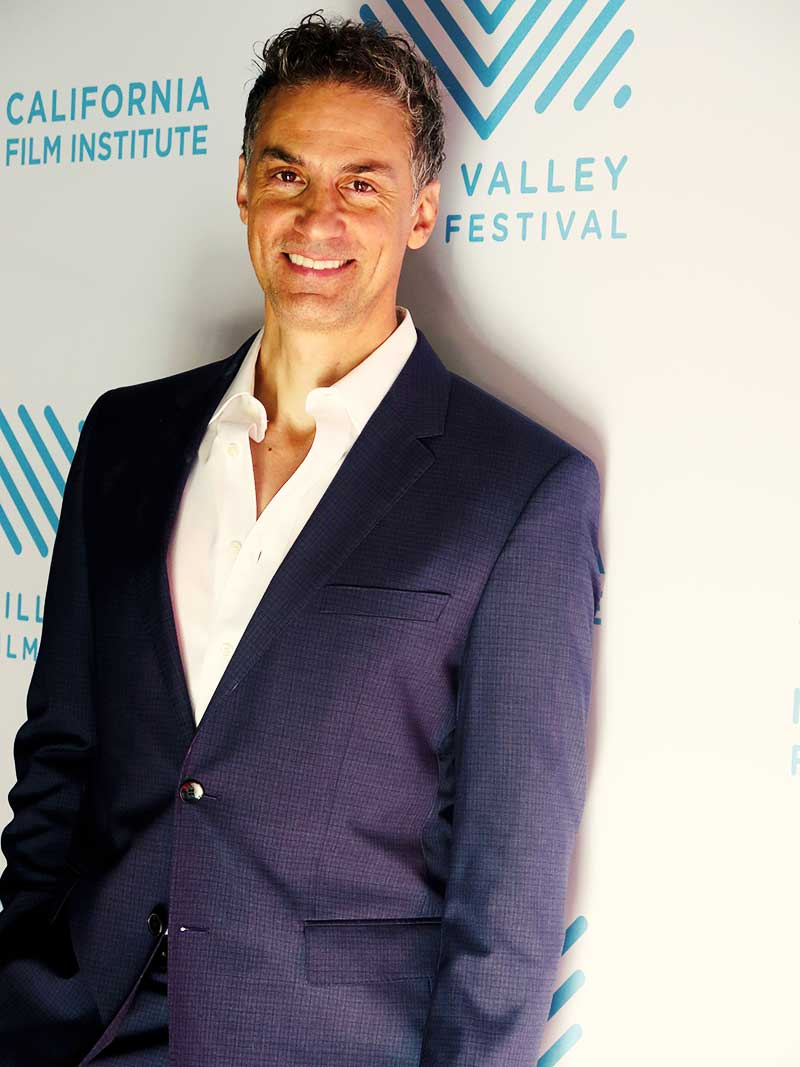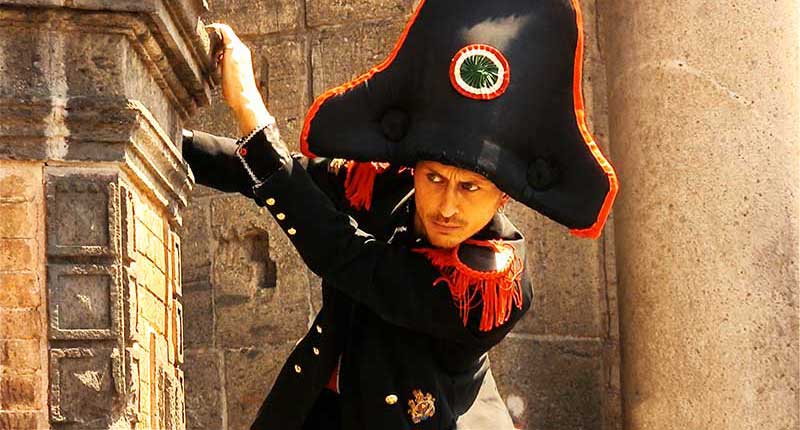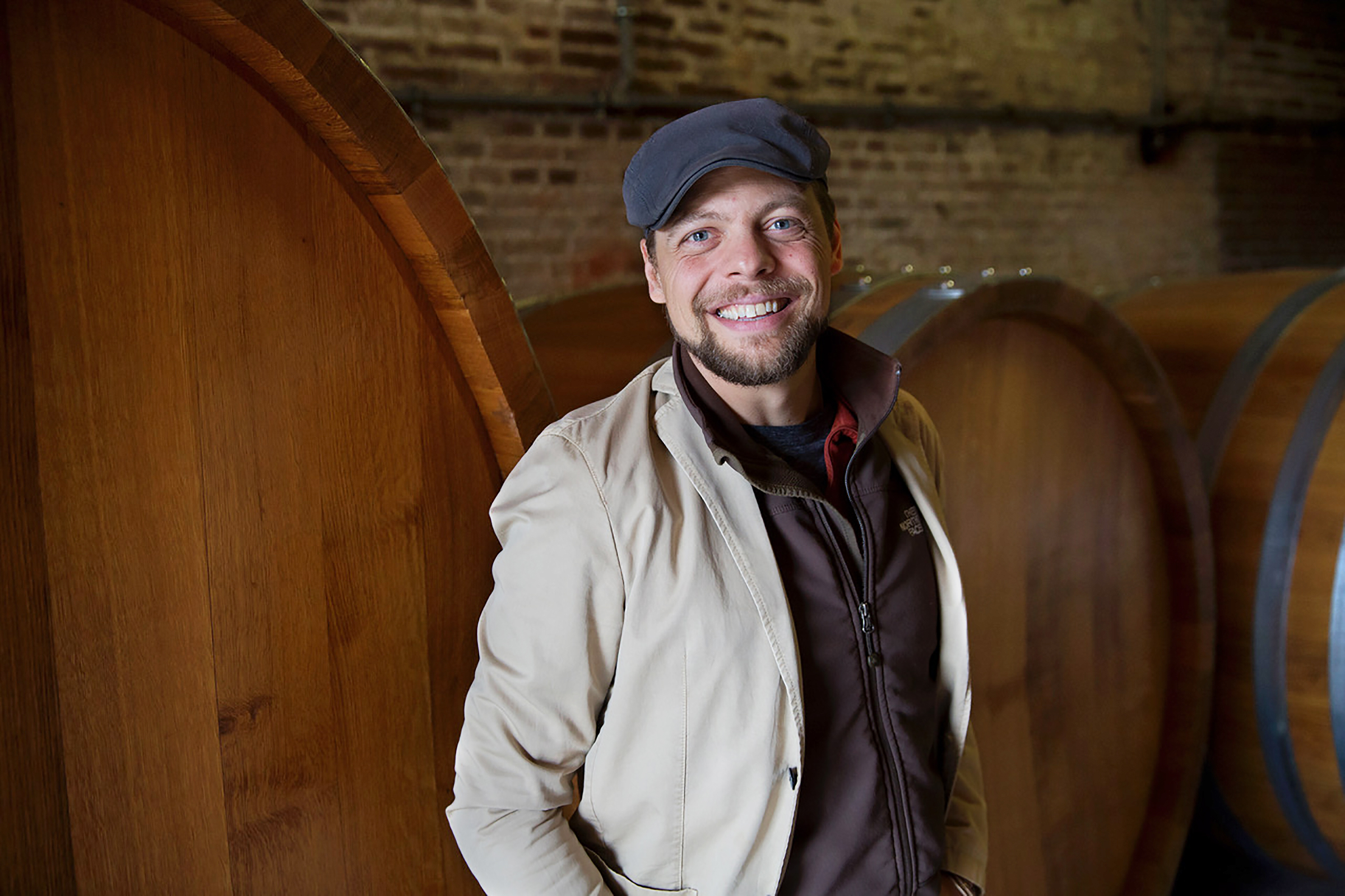It’s sunny in San Francisco on the Saturday afternoon before Memorial Day. Matteo comes to San Francisco from San Luis Obispo, before taking a flight to Chicago the next day. Matteo and I have been in touch for a few days now and I can immediately feel his excitement when we meet to talk about his film, Arrangiarsi (Pizza… and the Art of Living) that he is now touring around the US.
Once we introduce to each other, Director Matteo Troncone is the one starting the conversation: “Did you see him?” he asks. Surely he takes me by surprise, but only for a moment. Soon, it becomes clear that the “him” is actually his van. The Brown Bison, as Matteo calls it, is parked outside the café and there is no way it can go unnoticed: on both sides, you can read “Pizza and the art of living,” whereas the back shows the word “arrangiarsi,” in addition to stickers of all Festivals where the film was played, an Italian plate Matteo found on the road while visiting Italy, and the official plate customized as “Pizza.”

Troncone sitting on the roof of his beloved 1985 VW van, The Brown Bison @ Matteo Troncone
The 1985 VW van is only one, yet precious, part of Director Troncone’s life, in which – he confesses – serendipity and faith have played a big role. Matteo was born in an Italian-American family, with the four grandparents coming from the Bel Paese and searching new opportunities in the States. His granddad reached Pennsylvania, Matteo recalls, as many other immigrants who stopped in New York before moving to the city of adoption. Matteo and his family have spent their life in Mill Valley though, and he is the only one with an interest in acting and filmmaking.

Peppe, one of the many Neapolitans who became part of Troncone’s beautiful cinematographic vision @ Matteo Troncone.
Matteo followed his passion, he studied theatre at San Francisco State University and got his Masters degree at the Old Globe Theater in San Diego. What happens in between the degree and today is a blend of experiences, decisions, and serendipity, all contributing to making Matteo’s life extremely unique and fascinating. He filmed his story in Naples, edited it in California, and screened it in American theatres for a few years now.
Who was Matteo Troncone before “Arrangiarsi (Pizza… and the Art of Living)?” Before the film, he was somebody focused on getting acting work, looking outward, and depending on other people’s opinions in order to do what he was passionate about. Then, he became somebody opposite to that: now he is, instead, looking inward and embracing a truthful way of looking at life. He has simply become a maestro in surviving life events.

Matteo Troncone filmed his Arrangiarsi (Pizza and the Art of Living) entirely in Naples @ Matteo Troncone
Matteo, who went by Matthew during his acting career (“otherwise your name sounds like somebody’s owning a pizza place” a colleague suggested once), was in the running for a part in “Long Day’s Journey into Night,” but he was cut at the last minute. He had a falling out with family, he almost got killed by a Muni bus on Haight Street in San Francisco, and ultimately became single from one day to another via email, when his girlfriend of that time announced she had a new lover.

Arial view of Naples at night @Matteo Troncone
What changed then? “My life was at a turning point and, as it usually happens in any hero’s journey, I started with big losses. My family has played an important role in terms of values, culture, pride, and the language spoken at home. However, they weren’t too present in the moment I made those changes. The film represents the evidence of a faith walk, along which we learn whether or not the universe is friendly to us. In my career as an actor, I was always looking for validation, I worked to make other people happy, until something changed so radically that turned my career into something different. I was managing myself and taking care of every piece of the film. Moments of serendipity came, one after the other.”
When Matteo travelled to Italy to discover his parents’ roots, he decided Naples was the place. After he enjoyed pizza and the Italian life, he headed back to Mill Valley and decided he would make a film about pizza, even if he had never worked on a movie before. He got a free ticket to go back from a friend who could not use it and returned to Naples for 18 days to film artists, pizza makers, farmers, and flour producers.

Piazza Dante, Naples @Matteo Troncone
Matteo, tell us a bit more of how this documentary came to life.
I launched a kickstarter campaign in 2013, which lasted 45 days. People backed me up with $25K, which was what I asked in the campaign page. It took three years to come up with what we can see today: I had 130 hours of footage and spent 12 hours working, six days a week. I also had to go back to Italy one time because the audio I had taken at the Caputo Factory wasn’t good enough. On the other hand, I was lucky to have my friend from Trieste work with me for 10 days to translate all the parts spoken in Neapolitan. She literally worked as a “ciuccina” those days. On my hand, I was so inspired that I organized all my folders by topic and took care of each single piece of it.

Angelo e Sasa, due dei personaggi raccontati in nel film di Matteo Troncone @ Matteo Troncone
How did you choose the people who eventually worked or supported you in the project?
I do not believe in coincidence, I do believe in things happening as result of a divine orchestration: for instance, Peter Coyote saw me in a play and loved my performance. Randomly, we were at the same theatre one night in Sausalito and he asked how I was doing. I told him about my project and he eventually became involved with the voice over. However, when we recorded in 2016, the sound came out pretty bad and could not use it. When we decided to use my own voice for narration, he offered his help and supported anyways, he kept encouraging me and suggested to change the “art of survival,” as I first called it, into the “art of living.” Also Steve Bove, formerly at Walt Disney Studios, became the Creative Consultant and we met just because, when I moved into my new place, I found a free couch and he was the one giving it away. When I collected the couch, we started talking about my project and offered to help. That has been crucial for many reasons. For instance, when he helped me understand the use of whiteboards to return to the main topic of the film, the art of “arrangiarsi.”

The 1985 VW van is only one, yet precious, part of Director Troncone’s life, in which – he confesses – serendipity and faith have played a big role @ Matteo Troncone
Matteo is an active part of the movie, however his presence is not everywhere or overwhelming. What’s behind this choice?
To be totally honest, at the beginning, I didn’t even want to be part of it. But all the people who knew me and were following my work advised to be an active part of it. They suggested the story would be more interesting with me in there, as the art of “arrangiarsi” was and is a big part of my own life. My way to look at obstacles and the art of overcoming them would have made the story more appealing, even if I wasn’t necessarily mastering that art itself.

Matteo Troncone director and creator of Arrangiarsi @ Matteo Troncone
How did you find the experience of filming around Naples?
First of all, I was told to use a blue plastic bag for the camera. It would have made it safe to walk around and film people. It just looked like a grocery bag. Then, I was going around meeting artists and, at some point, I was also selling cartoline made from my photos. That facilitate some relationships with other street artists, like for example Peppe Martinelli. He allowed me to follow him for three days, shooting his performances around the city. There were also tough places where I could not film at all, and people were asking to not use my camera there.

Neapolitan pizza is so unique, it’s included in the UNESCO’s list of intangible cultural heritage
What surprised you the most when you arrived in Italy the first time? And what was instead exactly what you expected?
One of the best memories is when I went to Villa Adriana, near Rome, and the guy from the factory I was visiting let me ride the wheat combine. I was so surprised that I could not believe it! On the other hand, in general, I did not have many expectations: that’s what you do when you don’t follow any agenda. Just to give you an example: I filmed the San Gennaro Catacombs and entered the site using a fake press pass. One year later, I was listening to NPR and there was an interview with the guy who let me in two times. I sent an email to congratulate him and discovered he knew my press pass was fake, and said: “We all knew you had a good heart and you were working hard to show the beauty of Naples”. That was unexpected for sure.

Gianluca, uno dei tanti Napoletani che hanno preso parte al lavoro di Matteo Troncone @ Matteo Troncone
If Naples did not happen to be the city of this film, which one would have been?
Let me tell you: if it wasn’t Naples, the film wouldn’t exist. After my first time there, the friend who came when I was filming some new shots told me: “You are not making a film about pizza, you are doing something more.” She was totally right. I changed the purpose of the film and believed her because my soul knew what the film was about before my brain did.
Which was the best part of this project?
Eating pizza and meeting new people represented the sex part of the project. Then, when the baby – the movie – was born, I had to start dealing with changing diapers, which means for me getting the word out there. I loved when Neapolitans say I captured the essence of the city. I did not play the camorra card or something similar. As an Italian-American, I know what Italy is because I learned it through my family, but I come with the eyes of somebody from California and can see things more objectively. I screened in Los Angeles and I loved to see how people were touched by the story and I am impressed by the inspiration I can bring into the world.
How does your life look like right now?
Today, I live on the road: I have an office in San Luis Obispo and my van, Bison, is my home wherever I go. It never gives up and is always going. I also discovered how much I love editing, not only is fun but it’s also where magic happens.
What does the art of “arrangiarsi” mean to you today?
To me, “arrangiarsi” means allowing things to happen, listening to myself, and letting spirituality guide me. Thanks to this film, I learned to trust myself as an artist and as a filmmaker, in my own voice.
Before I take a photo of Matteo next to his van, I realized I have another, last question. Will be there any part two, I wonder. Matteo says there won’t be any part two, because the second part of the project is touring the film and making sure people are able to watch it. The film hasn’t been screened in Italy, although Matteo tried to get into some big festivals. He is right now his own publicist and “just a guy in a van” looking for (and hopefully finding soon) other ways than festivals to have it shown in Naples and Italy. Serendipity, he concludes, will do the rest.
The movie will have a screening on Wednesday, June 5th at the Laemmle Fine Arts Theatre (Screening 7:30pm. Pizza reception 6:30pm). From June 7th to 13th at the Laemmle Music Hall 4:30 pm dailyJune 11th at Laemmle Monica at 7pmJune 12th at Laemmle Pasadena Playhouse at 7pm.































